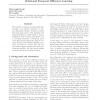106 search results - page 1 / 22 » Using relative novelty to identify useful temporal abstracti... |
ICML
2004
IEEE
14 years 6 months ago
2004
IEEE
lative Novelty to Identify Useful Temporal Abstractions in Reinforcement Learning ?Ozg?ur S?im?sek ozgur@cs.umass.edu Andrew G. Barto barto@cs.umass.edu Department of Computer Scie...
NIPS
2008
13 years 6 months ago
2008
In this theoretical contribution we provide mathematical proof that two of the most important classes of network learning - correlation-based differential Hebbian learning and rew...
IJCAI
2007
13 years 6 months ago
2007
We introduce an approach to autonomously creating state space abstractions for an online reinforcement learning agent using a relational representation. Our approach uses a tree-b...
ICML
2006
IEEE
14 years 6 months ago
2006
IEEE
We introduce relational temporal difference learning as an effective approach to solving multi-agent Markov decision problems with large state spaces. Our algorithm uses temporal ...
COST
2009
Springer
13 years 3 months ago
2009
Springer
Synchrony is claimed by psychology as a crucial parameter of any social interaction: to give to human a feeling of natural interaction, a feeling of agency [17], an agent must be a...

